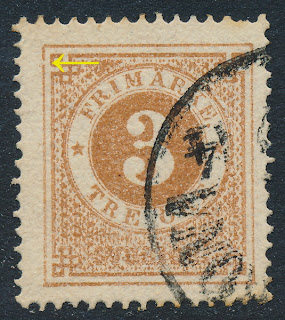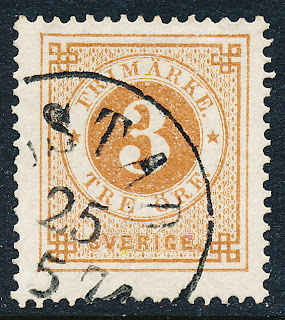After a hiatus of some years-- during which I was not entirely sure how I wanted to approach my entire Ringtyp stamp collection-- I have decided to look up this old site again.
Oddly enough, I come to this place through a rather "backwards" approach.
Due to unexpected financial issues in our lives, I recently had to sell my more "serious" collections of Denmark and Sweden, in order to pay a variety of life's expenses.
Now that the dust has somewhat settled, what remains is my messy accumulation of Ringtyp stamps, gathered over a period of decades... with an eye towards "eventually" getting around to building a specialized collection.
Maybe that "eventually" has finally arrived.
Not making any great promises here, but at least I am prepared to lay out some kind of initial thought, here.
The Ringtyp Stamps of Sweden, 1872-91
A site dedicated to the philatelic study of this classic stamp issue, including plate varieties, printings and postmarks.
Saturday, July 16, 2016
Monday, February 6, 2012
Facit 17: 3 öre Ringtyp, perf 14, Variety 1
Facit 17 (or Scott 17)
3 öre Ringtyp, perf 14
Variety ID: 17-001
Description: Small break in the left frame, near top. Observed on stamp postmarked 1874.
Examples curently known: 1
3 öre Ringtyp, perf 14
Variety ID: 17-001
Description: Small break in the left frame, near top. Observed on stamp postmarked 1874.
Examples curently known: 1
 |
| Click on image to see full size |
Labels:
3 öre perf. 14,
Circle type,
Facit 17,
Ringtyp,
Swedish stamps
Sunday, February 5, 2012
Scanning Experiment 2: Facit 17
Just like you sometimes have to "lie" to a digital camera, sometimes you have to "lie" to a scanner.
In this case, I inserted strips of white paper into the adjacent strips on the Hagner sheet. This made the scanner "think" that there was more pale material on the page, so it compensated by making the base scan darker. This version of a scan of the same stamps as before has not had any light removed.
However, I am still not happy with the lack of color differentiation. The two stamps-- which look quite different to the naked eye-- look very close to the same, on the scans.
At the moment, the scanner is on a "photograph" setting, which I figured would be the closest to the color requirements of scanning stamps. Maybe I need to look into different scanner settings.
I may experiment with this for a while, because if I am going to put a bunch of effort into putting these stamps on a web site, I want to put out good results.
Of course, the effectiveness of this web site is going to be limited by the quality and color rendition algorithms of the monitors belonging to the people who view the site. So it can never really be "perfect," and I don't even know if the color rendition of my own monitor is a good representation of what the broader population of stamp collecting computer users might see.
Both of these stamps remain a little too pale/subdued, color-wise. What's nice, though, is that the paper color is about right. The paper on these is not bright white, but a yellowish cream. SO, getting closer...
So many things to DO, before I get started.
Scanned as two stamps surrounded by white strips.
Scan included part of white area.
Sharpen 40% to reduce noise.
Not color corrected.
 |
| Better exposure level. Now a little too gray. |
However, I am still not happy with the lack of color differentiation. The two stamps-- which look quite different to the naked eye-- look very close to the same, on the scans.
At the moment, the scanner is on a "photograph" setting, which I figured would be the closest to the color requirements of scanning stamps. Maybe I need to look into different scanner settings.
I may experiment with this for a while, because if I am going to put a bunch of effort into putting these stamps on a web site, I want to put out good results.
Of course, the effectiveness of this web site is going to be limited by the quality and color rendition algorithms of the monitors belonging to the people who view the site. So it can never really be "perfect," and I don't even know if the color rendition of my own monitor is a good representation of what the broader population of stamp collecting computer users might see.
 |
| The color on these two is NOT the same. |
So many things to DO, before I get started.
Scanned as two stamps surrounded by white strips.
Scan included part of white area.
Sharpen 40% to reduce noise.
Not color corrected.
Scanning Experiment 1: Facit 17
I needed to experiment with the scanner, and decided to start at the start, with the 3 öre perf 14, Facit nr. 17.
Mostly, I wanted to test out how well I'd be able to distinguish color shades in the electronic medium, and how to work with the "exposure."
The issue with my otherwise excellent scanner is that it tends to overexpose stamps when there are just a few of them on the black background of a Hagner sheet.
The first two did NOT go well. Clearly overexposed. A dark brown, grainy print from one of the early printings shows up pale orange-brown, and not very different from a much paler brown of a later printing.
The paper shows as bright white, and it is not-- more of a grayish-cream shade; not quite "yellowish."
These were even color corrected-- removed 30% light from the original scan, and they still look much too light.
The good news is that the "popout" feature works. If you click on the stamp image, a larger version opens in a new tab. This will be very useful for illustrating varieties.
Back to the drawing board.
Scanned as two stamps alone on black Hagner sheet.
600dpi
Light reduced 30%
 |
| Way overexposed. Even after removing 30% light. |
The issue with my otherwise excellent scanner is that it tends to overexpose stamps when there are just a few of them on the black background of a Hagner sheet.
The first two did NOT go well. Clearly overexposed. A dark brown, grainy print from one of the early printings shows up pale orange-brown, and not very different from a much paler brown of a later printing.
The paper shows as bright white, and it is not-- more of a grayish-cream shade; not quite "yellowish."
These were even color corrected-- removed 30% light from the original scan, and they still look much too light.
The good news is that the "popout" feature works. If you click on the stamp image, a larger version opens in a new tab. This will be very useful for illustrating varieties.
Back to the drawing board.
Scanned as two stamps alone on black Hagner sheet.
600dpi
Light reduced 30%
Saturday, February 4, 2012
About this blog
Welcome!
This site is intended to serve as an adjunct to my primary web site dedicated to the Swedish "ringtyp" stamp issue of 1872-91.
The blog "format," with dateable and sortable posts, lends itself better to updates and to "inserting" new finds in order, than a "static web site." I am by no means abandoning the original site-- I am merely adding to it, using a more flexible format.
It may be a while before much of anything appears here. Catalogueing varieties and postmarks on such an extensive stamp issue takes time. My database on my computer is already huge, and I intend to upgrade the quality of the photos of all the minor plate varieties I have found, allowing other collectors to cross-reference with their own collections.
Hopefully, some people might pass by this site and decide to take up a new specialty!
In time, I also hope to collaborate with the "Swedish Ring Study Circle" that's part of the Scandinavian Collectors Club, as well as with collectors and clubs around the world.
This site is intended to serve as an adjunct to my primary web site dedicated to the Swedish "ringtyp" stamp issue of 1872-91.
 |
| Selection of Ringtyp stamps with superb cancels |
It may be a while before much of anything appears here. Catalogueing varieties and postmarks on such an extensive stamp issue takes time. My database on my computer is already huge, and I intend to upgrade the quality of the photos of all the minor plate varieties I have found, allowing other collectors to cross-reference with their own collections.
Hopefully, some people might pass by this site and decide to take up a new specialty!
In time, I also hope to collaborate with the "Swedish Ring Study Circle" that's part of the Scandinavian Collectors Club, as well as with collectors and clubs around the world.
Labels:
About us,
Cancels,
Circle type,
Introduction,
Ortstämplar,
Postmarks,
Ringtyp,
Swedish cancels,
Swedish stamps,
Town cancels
Subscribe to:
Posts (Atom)


